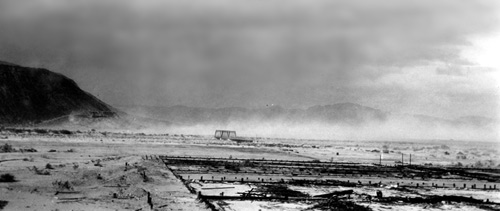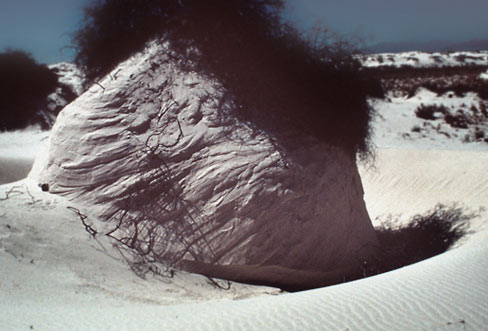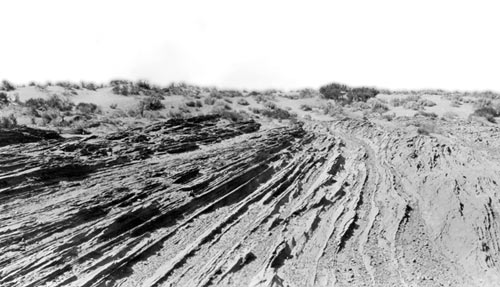Wind in a tornado has been clocked at just over 300 mph, a big hurricane (category 5) can have gusts over 200 mph, but because air has a much lower density than water, it has a limit of what it can move.
Strong winds 50 km/hr (~30 mph) can only lift items as large as sand. At this speed the wind can keep aloft sand particles. At about 16 km/hr (10 mph) the wind can move sand particles along the ground and this is called Surface Creep.
If the wind gets a little faster the sand can be lifted and moved along like a stream using saltation. As the speed of wind increases its ability to move sand goes up faster than the expected 1 to 1 correlation. Doubling wind speed from 30 km/hr (18 mph) to 6o km/hr (37 mph) will triple its ability to move material.
Continuous but
relatively low speed wind across a sand dune will produce a
series of "ripples". They are actually the sorted top
material and represent the largest sand particles that the
wind is just incapable of moving.
They will form a
series of ridges that are perpendicular to the wind
direction. They look like a series of small waves. If the
wind grows stronger, and it able to move all the sand sizes,
then the ripples disappear.
The dustiest places on earth are those place where the sorting process has left behind the smallest particles. In these even gentle winds can move the material about.
So where are places that leave behind well sorted, small material? Lake beds, river beds, alluvial fans, and old land raised deltas.
Wind blowing across a flat area produces little or no turbulent flow at the ground level. ( about 0.5 mm above the ground) It requires some sort of disturbance to get this material in motion.
Saltation can provide the disturbance by dropping larger particles on the smaller, and creating tiny wind blockages that make the air form eddies. Eddies provide buoyancy to the fine dust and keep it suspended. Thus it can travel for a greater distance before losing its battle with gravity.

Mojave Desert Dust Storm
Dust will fall from its airborne suspension if ...
1.) the wind velocity ceases or drops below that necessary to create the eddying effect.
2.) if it strikes a surface that can trap it
3.) the articles themselves accumulate (stick together) and become too large
4.) encounter rain and are washed out of the sky.
Other less desirable ways to stop dust ...
Run it into a car windshield and turn it into frosted glass, run it into the side of a car and remove all the paint making it a nice shinny surface. It is also detrimental to the engine of a car in several different areas including, the various filters, electrical circuits and the engine itself.
It reduces visibility and temporarily blinds those caught in a dust storm. It can cause medical problems especially with those who have asthma or other breathing problems. It can also act a vector for disease.`
Wind and dust can erode something in two ways, first by
1.) Deflation: the process of removing small material and letting the large material stay where it is. This effectively created a protective flat area once the small material was gone leaving behind only a pebble or gravel floor. If there is sufficiently large material left behind it may form a desert pavement. It can destroy fertile ground during a drought by removing all of the soil and sorting the ground back to rock.
Hallows and Basins: Typically a long slightly hallowed out depressions that can hold water during a rain but is dry throughout most of the year.

Death Valley Desert Pavement
2.) Ventifacts: the act of abrading away a higher standing stone by effectively sand blasting it with fine hard particles in the wind. the larger stone develop a flat and sometimes polished surface on the up wind side.
3.) Yardangs: a yardang is a fin like structure that points in the direction of the wind. They are formed when something more substantial than lose sediment is encountered. They are often hard compacted sediment that is more resistive to the deflative process.

White Sands Wind abbraded rock

Yardang type structure
| NEXT | TOC | PREV |